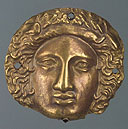Q1 : Who painted this work representing Midas and Bacchus (circa 1629-30) ? Midas greets Silenus, old
companion and teacher of Bacchus. He organizes a beautiful feast in his honor.
To To thank him, Bacchus gives Midas the ability to transform everything he
touches. But as soon as his wish is said, everything, including his food, changes
when he touches it. Q2 : What does everything transform itself into? Upon his bequest, Bacchus
delivers him from this gift, and tells him to bathe in a river, which since then rolls
over gold. Q3 : What is the name of this river? the punishment of Midas Q4 : Who painted this work? Midas preferred the flute of
Pan to the lyre of Apollo. The god was irritated and punished him. Q5 : What is his punishment? Midas hides his deformity,
but someone finds out his secret. Q6 : Who discovers the secret of king Midas? Q7 : Who painted this work: "Midas bathing in the Pactole" from 1627 ? The one who discovers his
secret, could not keep it and confides it to the earth after digging a whole which he/she
hurries to fill, but in that spot reeds start to grow... Q8 : What do the reeds whisper whenever the wind blows? Q9 : Who wrote about the cult of Bacchus in " Birth of tragedy"? Q10 : Who painted this "Feast of Midas" ?
 BACCHUS
et MIDAS - 10
BACCHUS
et MIDAS - 10
 BACCHUS
et MIDAS - 10
BACCHUS
et MIDAS - 10